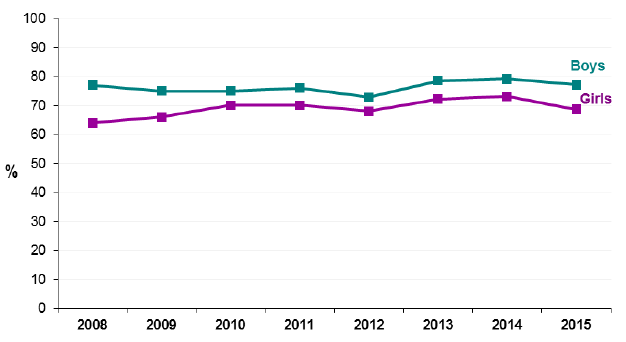Obesity indicators 2016
The latest data for indicators selected to monitor progress for the Prevention of Obesity Route Map (2010).
This document is part of a collection
Child physical activity
Indicator Source: Scottish Health Survey
Latest Results
- In 2015, 73% of children were active for an average of 60 minutes per day (including school-based activity). This is a similar proportion to that seen in 2008 and 2009 (71%). Boys (77%) remain more likely than girls (69%) to be active at this level.
- Prior to 2008, data were only collected excluding school-based activity. Using this measure, the proportion of children active for an average of 60 minutes per day has fluctuated at between 62% and 70% (the figure in 2015 was 66%).
- Boys are generally more physically active at all ages, but the difference is particularly pronounced in the early teenage years. Only 46% of girls aged 13-15 are active for an average of 60 minutes per day (including school based activity), compared to 78% of boys. A similar gap was observed when school-based activity was excluded.
Figure 10: Proportion of children (2-15) active for an average of 60 minutes per day (including school based activity), by gender, 2008-2015

- Inequalities in the proportion of children active for an average of 60 minutes per day (including and excluding school based activity) have fluctuated over time.
Figure 11: Proportion of children (2-15) active for an average of 60 minutes per day (including school based activity), by area deprivation [9] , 2008-2015
![Figure 11: Proportion of children (2-15) active for an average of 60 minutes per day (including school based activity), by area deprivation[9], 2008-2015 Figure 11: Proportion of children (2-15) active for an average of 60 minutes per day (including school based activity), by area deprivation[9], 2008-2015](/binaries/content/gallery/publications/statistics-publication/2016/12/obesity-indicators-monitoring-progress-prevention-obesity-route-map-december-2016/00511062.gif)
- However, sports participation among 2-15 year olds is considerably higher in the least deprived areas (79% in 2015, compared to 55% in the most deprived areas).
About This Indicator
Desired Outcome:
Increased energy expenditure.
Definition:
Accumulating 1 hour or more of moderate intensity physical activity on average every day of the week. The questions in the Scottish Health Survey were changed in 2008 to include school-based physical activity. It is possible to look at trends since 1998 excluding school-based activity.
Relevant Route Map action:
Early years actions, specifically less sedentary activities for young children.
Geography available:
National, Health Board.
Equalities data:
Breakdowns by equalities groups are possible but not all are available annually.
Rationale:
The aim of this indicator is to monitor the proportion of children (aged 2-15 years) accumulating 60 minutes or more of moderate intensity physical activity on average every day of the week. Although surveys indicate no significant association between children's activity and their BMI, research suggests that focusing on physical activity is important as part of a wider weight management strategy for children.
Factors influencing this indicator:
- Availability of safe outdoor places.
- Access to leisure facilities.
Contact
There is a problem
Thanks for your feedback